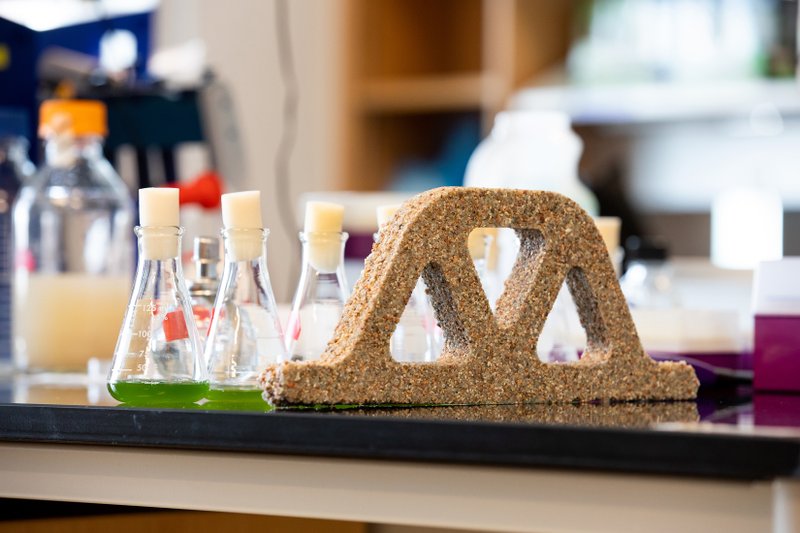For centuries, builders have been making concrete roughly the same way: by mixing hard materials like sand with binders and hoping it stays fixed and rigid for a long time to come.
Now, an interdisciplinary team of researchers at the University of Colorado, Boulder, has created a rather different concrete — one that is alive and can even reproduce.
Minerals in the new material are deposited not by chemistry but by cyanobacteria, a common class of microbes that capture energy through photosynthesis. The photosynthetic process absorbs carbon dioxide, in stark contrast to the production of regular concrete, which spews huge amounts of that greenhouse gas.
These bacteria also make the concrete green. "It really does look like a Frankenstein material," said Wil Srubar, a structural engineer and the head of the research project. The green fades as the material dries.
Other researchers have worked on bringing biology into concrete, especially concrete that can heal its own cracks. An advantage of the new material, its creators say, is that instead of adding bacteria to regular concrete — an inhospitable environment — their process enlists bacteria to build the concrete and keeps them alive so they make more later on.
The new concrete, described in the journal Matter, "represents a new and exciting class of low-carbon, designer construction materials," said Andrea Hamilton, a concrete expert at the University of Strathclyde, in Scotland.
To build the living concrete, the researchers first tried putting cyanobacteria in a mixture of warm water, sand and nutrients. The microbes eagerly absorbed light and began producing calcium carbonate, gradually cementing sand particles together. But the process was slow — and DARPA, the U.S. Defense Advanced Research Projects Agency and the project's funder, wanted the construction to go very quickly.
BETTER WITH GELATIN
Srubar had worked with gelatin, a food ingredient that, when dissolved in water and cooled, forms special bonds between its molecules. Importantly, it works at moderate temperatures that don't kill bacteria. He suggested adding gelatin to strengthen the matrix being built by the cyanobacteria.
The researchers bought Knox brand gelatin (at a supermarket) and dissolved it in the solution with the bacteria. When they poured the mixture into molds and cooled it in a refrigerator, the gelatin formed its bonds — "just like when you make Jell-O," Srubar said. The gelatin provided more structure and worked with the bacteria to help the living concrete grow stronger and faster.
After about a day, the mixture formed concrete blocks in the shape of whatever molds the group used, including 2-inch cubes, shoebox-size blocks and truss pieces with struts and cutouts. Individual 2-inch cubes were strong enough for a person to stand on, although the material is weak compared to conventional concretes. Shoebox-size blocks showed potential for doing real construction.
"The first time we made a big structure using this system, we didn't know if it was going to work, scaling up from this little-bitty thing to this big brick," said Chelsea Heveran, now an engineer at Montana State University and the lead author of the study. "We took it out of the mold and held it. It was a beautiful, bright green and said 'DARPA' on the side."
When the group took small samples to a meeting with DARPA, they were impressed, Srubar said: "Everyone wanted one on their desk."
MOTHER BRICKS
Stored in relatively dry air at room temperature, the blocks reach maximum strength over the course of days, and the bacteria begin to die out. But even after a few weeks, the blocks are alive; when exposed to high temperature and humidity, many of the bacteria perk back up.
The group can take one block, cut it with a diamond-tipped saw, place half back in a warm beaker with more raw materials, pour it in a mold, and begin concrete formation anew. Each block could spawn three generations, yielding eight descendant blocks.
The Department of Defense is interested in using these "LBMs" — living building materials — for construction in remote or austere environments. "Out in the desert, you don't want to have to truck in lots of materials," Srubar said.
Most concrete requires the virgin sand that comes from rivers, lakes and oceans, which is running short worldwide, largely because of the enormous demand for concrete. The new material is not so picky. Srubar said, "We could use waste materials like ground glass or recycled concrete."
The research team is working to make the concrete stronger, increasing the bacteria's resistance to dehydration, reconfiguring the materials so they can be flat-packed like slabs of drywall and finding a cyanobacterium that doesn't require the addition of a gel.
Eventually, Srubar said, the tools of synthetic biology could dramatically expand the realm of possibilities: for instance, building materials that detect and respond to toxic chemicals, or that light up to reveal structural damage. Living concrete might help in environments harsher than deserts: other planets, like Mars.
Style on 02/03/2020
